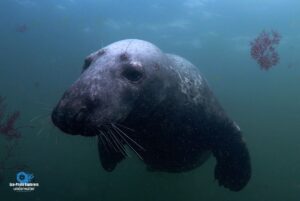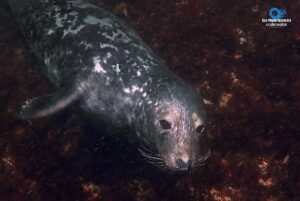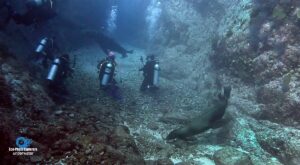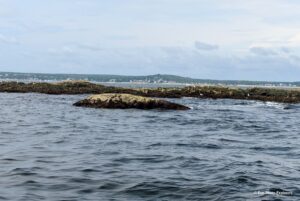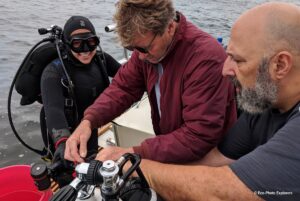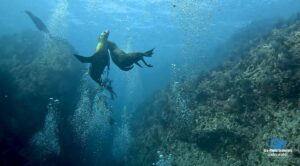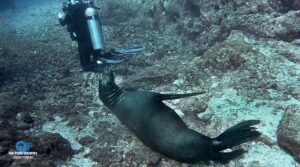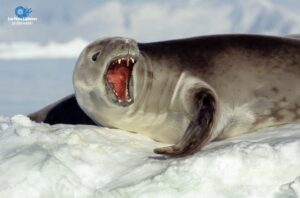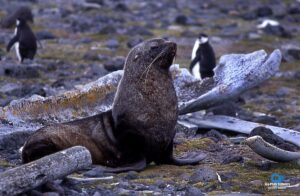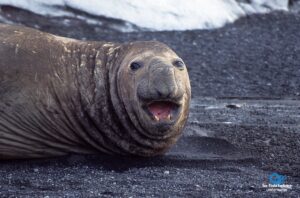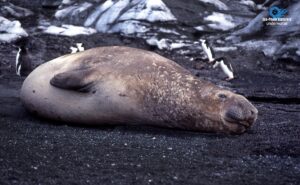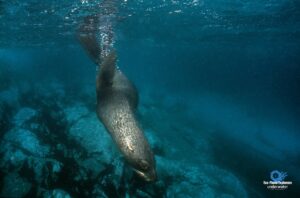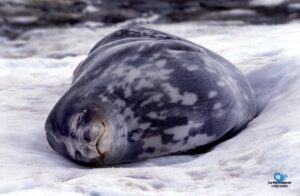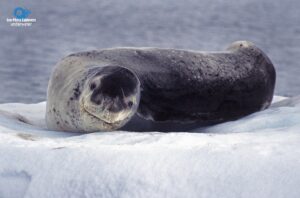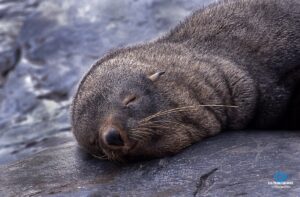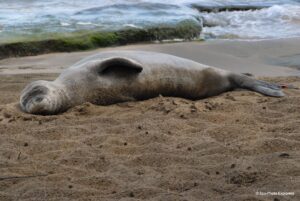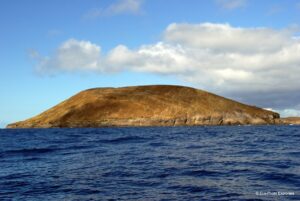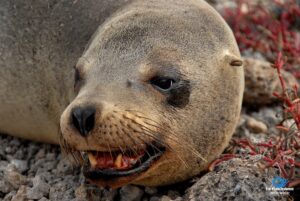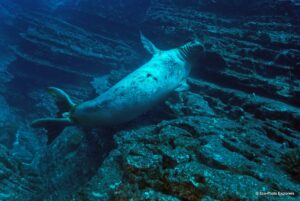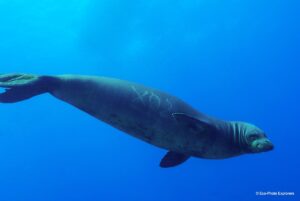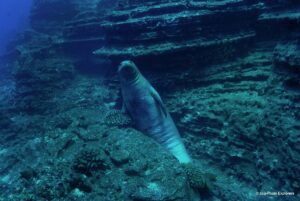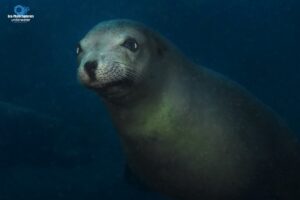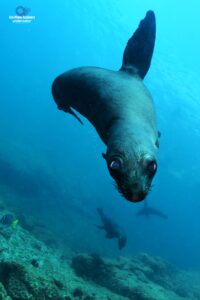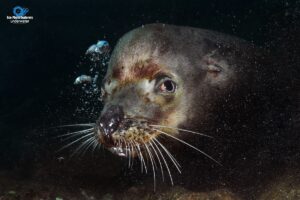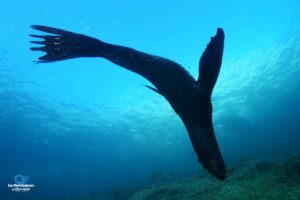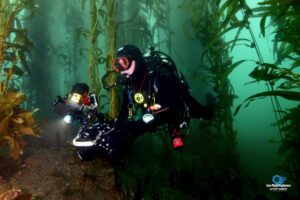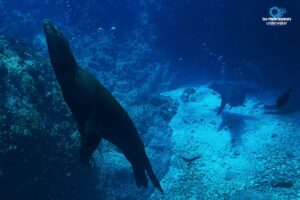The underwater world presents a boundless cornucopia of mystery and wonder to SCUBA divers. Colorful reefs teeming with life, sunken ships shrouded in mystery, extreme environments that present challenges and the prospect of new discoveries are just part of the menu of diving opportunities to be experienced in the underwater world.
Some of the most rewarding times spent underwater involve contact with other species. And for us air breathing humans, dives that bring us closer to marine mammals are some of the most memorable. For example, whales and dolphins will often eye divers with a knowing intelligence and a real curiosity to understand who we are. Those encounters can be powerful and emotionally moving.
For many divers, the chance to dive with Pinnipeds represents the ultimate marine encounter.
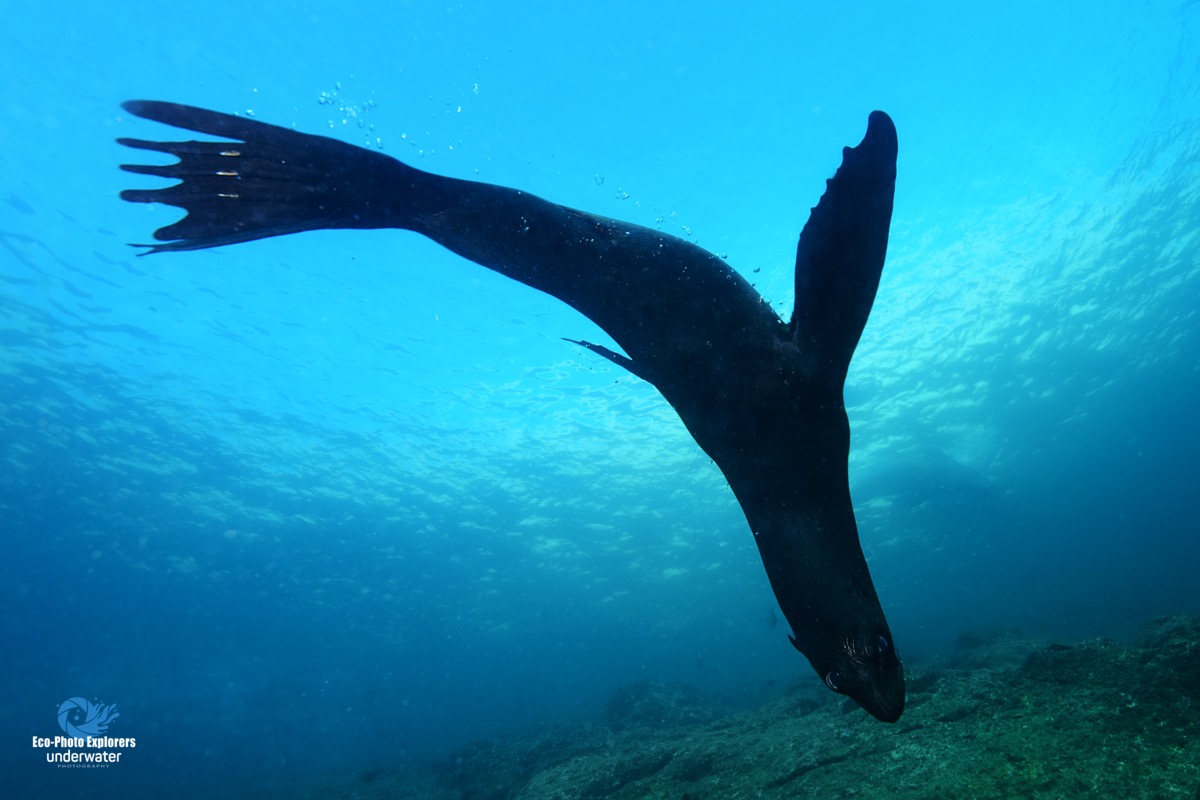
California Sea Lions are master swimmers
The word “pinniped” means fin- or flipper-footed and collectively refers to marine mammals that have front and rear flippers. This group includes seals, sea lions and walruses — animals that live in the ocean but are able to come on land for long periods of time.
Diving with Walruses is extremely dangerous and should only be attempted in certain very carefully managed situations. Walruses are polar animals so this type of diving involves cold water conditions and divers must first be adept at handling that type of environment. But more importantly, walruses are large, aggressive animals that can inflict serious damage with their tusks and heads. For the purposes of this article, we are going to focus on other members of the Pinniped family – namely, seals and sea lions.
Before we go diving with these creatures, we first must explain the difference between a Seal and a Sea Lion because many people confuse the two and use the names interchangeably. There are several physiological differences that makes identification easy: seals are generally smaller than sea lions (although there are several notable exceptions) and they have ear holes while sea lions have small flaps by their ears.
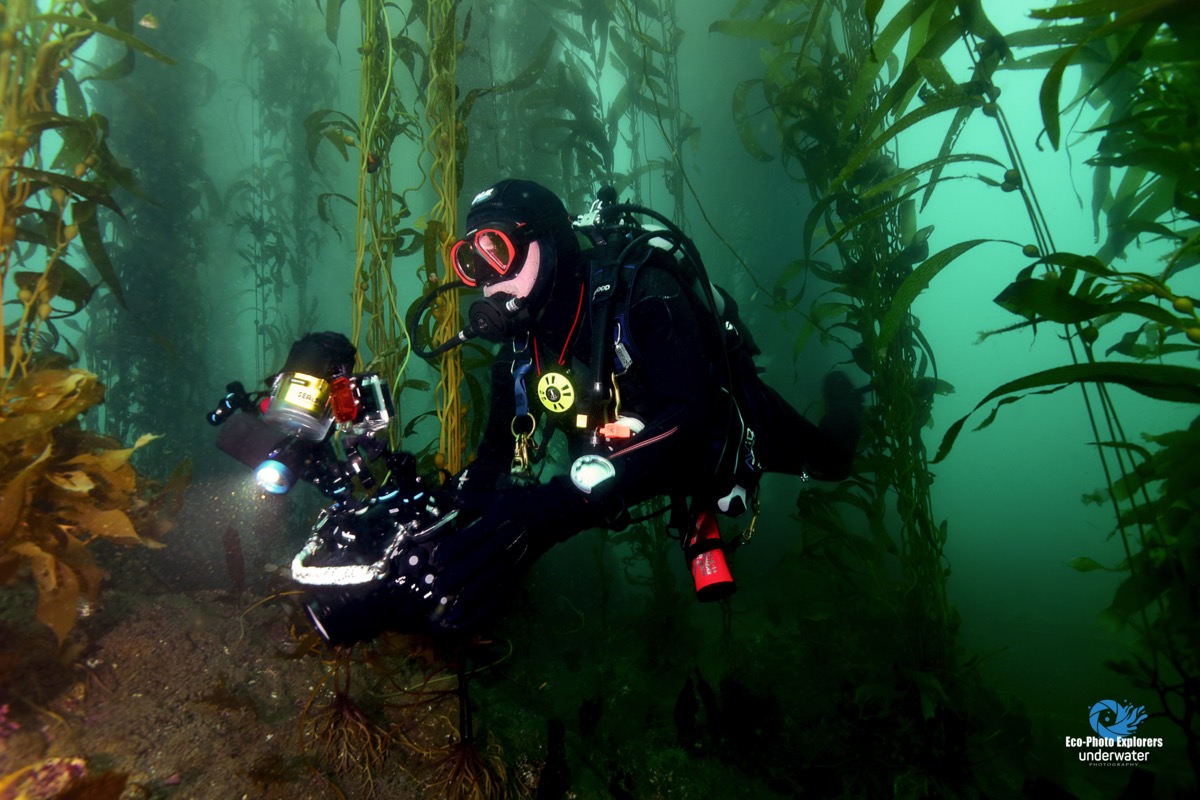
Author Christopher Weaver searches the kelp forests in California for Harbor Seals
Story and photos by Michael Salvarezza and Christopher P. Weaver
Perhaps the most visible difference lies in the flippers. The rear flippers of a seal point away from their body and are used for propulsion through the water while Sea Lions can rotate their rear flippers and use them to actually walk on land. Seals use their belly to move on land. The front flippers of a sea lion are large, elongated and used to pull the animal through the water while the front flippers of a seal are much smaller.
Although these differences are useful in distinguishing between the two types of animals, one thing is true for both: encountering them underwater is a magical experience!
Diving with marine mammals, and pinnipeds in particular, requires that divers respect the animals and be aware of the behavioral signals they may display to communicate with you. Additionally, different jurisdictions have varying rules for interacting with these animals and these can be very different based on the country whose waters you are diving in.
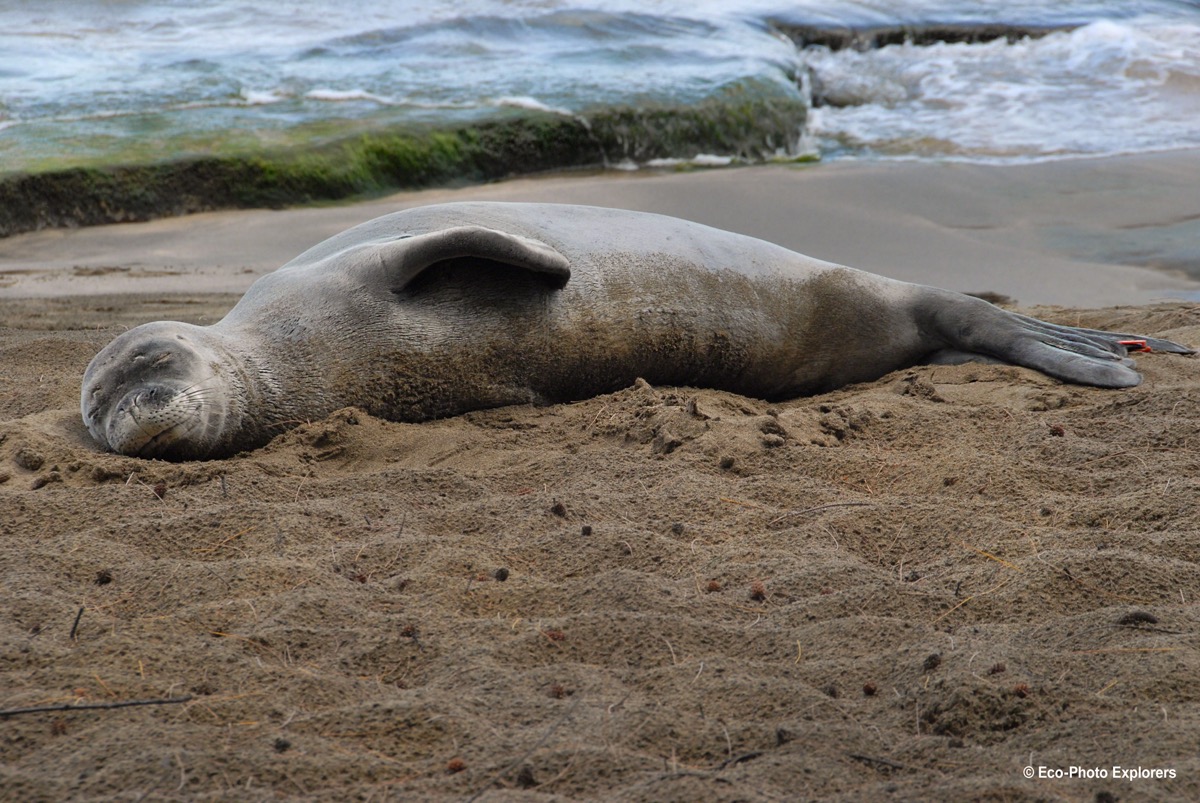
An endangered Hawaiian Monk Seal sleeps on the shores of Kauai
For example, the Hawaiian monk seal is the most endangered pinniped in U.S. waters and one of the most endangered seals worldwide. The law in Hawaii requires that divers do not approach, harass or feed Monk Seals and that a 150 foot distance be maintained from the animal. However, the animals do not know the law and may approach divers!
Meanwhile, in Mexico the main Sea Lion rookeries are closed to swimmers during the breeding season, which runs through the later parts of August.
Even in the world’s most remote regions, laws often exist governing the interactions with marine mammals. In Antarctica, for example, leopard seals are protected by law under the ‘Antarctic Treaty’ and the ‘Convention for the Conservation of Antarctic Seals’. Leopard seals are also protected by law under the ‘Marine Mammals Protection Act (MMPA) 1978’ in New Zealand, under which it is an offense to disturb, harass, harm, injure or kill a seal. Anyone convicted of a violation may face a maximum penalty of two year’s imprisonment or a fine up to a maximum of $250,000
Regardless of the law, all divers should keep a respectful distance from these creatures, avoid harassing them in any way, and become aware of their individual behaviors so that interactions can be both enjoyable and safe. These behaviors vary from species to species and by location.
Let’s take a look at some of the best dive sites where divers can encounter Pinnipeds.
We will start in Mexico’s Sea of Cortez, where there are several locations where divers can swim with California Sea Lions.
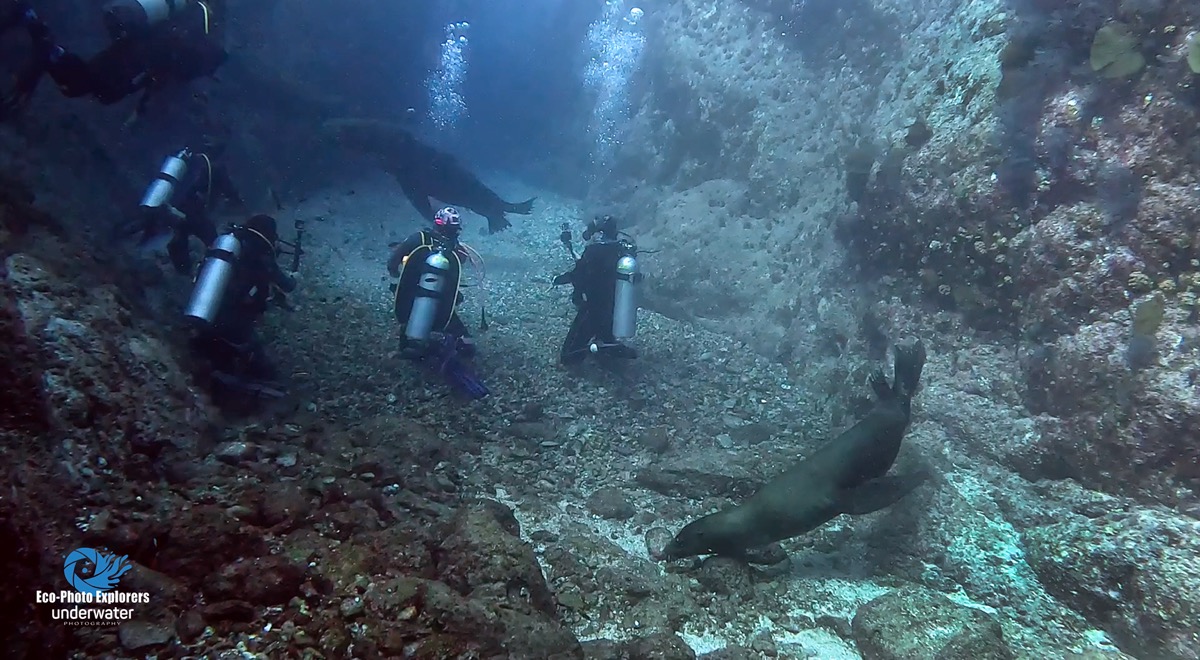
California Sea Lions surround divers in the Sea of Cortez
Near the port city of La Paz, and up to Loreto and points north, California Sea Lion rookeries at Los Islotos, La Reyna and Las Animas are popular dive sites where encounters with Sea Lions are both predictable and exhilarating. These sites are reachable by both liveaboard and shore-based diving operations and, often, from the time a diver splashes into warm waters of the Baja the experience is akin to a three-ring circus. Everywhere a diver will look there will be something amazing to look at. Resident California Sea Lions will be seen darting in and out of the rocks while inquisitive juvenile sea lions often approach carefully and begin nibbling at fins and eyeing divers with a playful gaze. All the while, divers will hear the sound of constant barking from dozens of pinnipeds enjoying the relative safety of the sheltered coves. Mixed in to the action might be a Guadalupe Fur Seal, which are also known to frequent these areas.
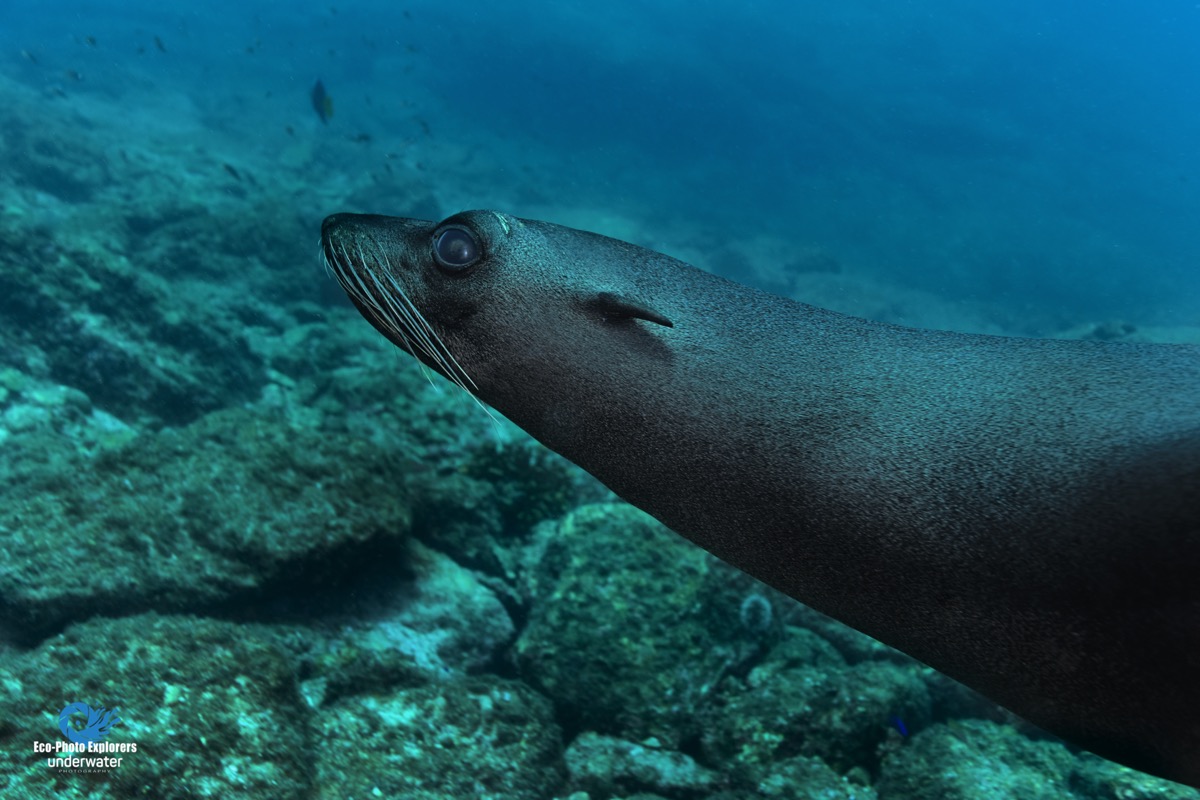
A California Sea Lion makes a close approach in the Sea of Cortez
Be careful though. The action can be mesmerizing and the desire might be to try to approach the Sea Lions to either get a better photograph or video, or to simply enjoy a moment of play. Be advised that the male “beach master” California Sea Lions, some weighing upwards of 400 pounds (181 kg) or more, will also be patrolling the water, keeping a close eye on the females and warning off any perceived threat. For divers, it is important to be aware that these males will exhibit predictable behaviors in an escalating fashion should they perceive the diver getting too close for comfort. First, the males will circle the diver, loudly barking and watching the diver from fairly close range. If the diver does not retreat, the bull male will indicate displeasure by swimming in a straight line in front of the diver and blowing a curtain of bubbles. And again, should the diver still be seen as a threat, the male will then rush the diver, baring his teeth and blowing bubbles directly into the face of the diver.
It all sounds entertaining until it happens to you! The sight of a 400-pound (181 kg) male bull sea lion rushing directly at you is definitely heart stopping! Pay attention to the first warning signs and back off, even if it’s the sea lions that are approaching you!
In the Cape Ann area of Massachusetts, near Gloucester, divers have the opportunity to interact with Grey Seals and Harbor Seals.
In this area are two rocky reefs known as The Salvages. The Dry Salvages face the Atlantic and are always dry even at high tide, while the Little Salvages, or Salvages, sit between the Cape Ann coastline and the Dry Salvages and are submerged during high tide. Diving the Little Salvages, which lie about 1 hour out from Gloucester or about two miles northeast of Rockport at low tide maximizes the chances of close encounters with the seals that inhabit this area.
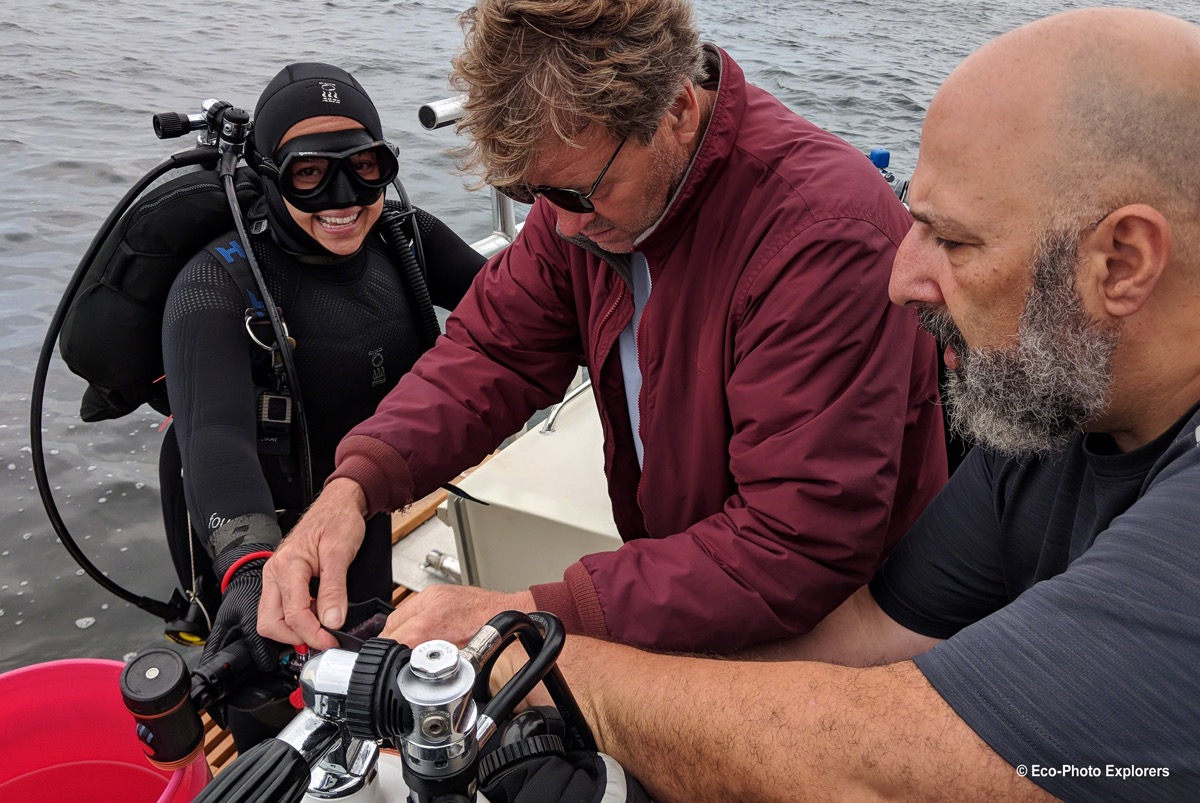
Although the water is shallow at The Savages, divers check their gear before diving
Divers who venture to this location come to dive with Grey Seals and, on occasion, Black Collared Harbor Seals. The seals find these rocks, which barely break the surface, an ideal spot to haul out. While the surrounding waters are rich in marine life, the rocks provide a platform for resting, warming up and escaping predators.
Grey Seals are found throughout the North Atlantic. They are fairly large seals, with bulls measuring upwards of 10 feet in length and weighing as much as 680 pounds. The species has a curiously shaped face and snout, which has inspired comparisons to dogs.
In the 1800s and early 1900s, the Grey Seal was hunted to virtual extinction. After the Congress passed the Marine Mammal Protection Act in 1972, a survey of the entire Maine coast found only 30 Grey Seals. However, since then populations have steadily grown. Healthy groups of seals can now be found from Maine down to Massachusetts, and even into New York and New Jersey.
With summertime water temperatures in the mid-60s (f) divers can either use 7-mm wetsuits or a dry suit to maximize the time in the water.
The dive plan is usually straightforward: boats anchor about 50-60 yards away from the rocks, and after a quick compass reading, divers enter the water quietly, and swim underwater towards a submerged area next to the rocky islands. There, in only 10 feet of water or less, divers wait patiently for the seals to approach.
Divers will hear the guttural growl and grunts of seals from beyond the edge of visibility. With seaweed and silt often stirred up from the surge, visibility may only be 10-12 feet.
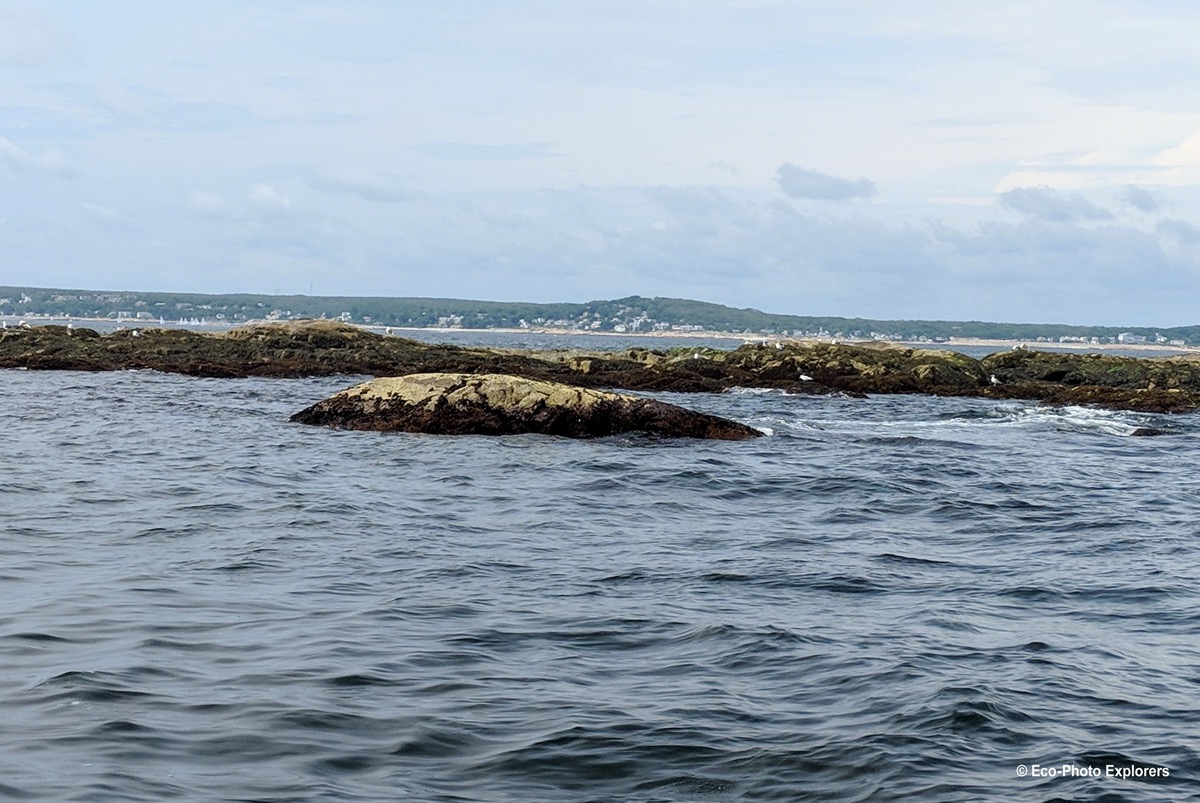
The Savages, near Gloucester, makes for a great dive site
It may take a little while for the seals to approach the divers but often they will eventually come within inches, inspecting cameras and eying divers inquisitively. Here, as in other areas of the world, divers should try to avoid inadvertently threatening the seals by not making direct eye contact and trying not to make any aggressive movements. On occasion, bulls may deliver a direct message letting you know not to mess with his harem by blowing bubbles, loudly barking or rushing at divers that they perceive as a threat.
Eighteen miles west of the Hawaiian island of Kauai and 138 miles southeast of the closest Northwestern Island lies the privately-owned island of Niihau, measuring six by 19 miles, with fewer than 200 residents. It is known as the “Forbidden Island” because the owners have traditionally refused any requests by outsiders to land on the island. This lonely rock in the Pacific Ocean has thus taken on an aura of mystery and intrigue.
Diving the island of Niihau is rare opportunity for adventurous divers who are willing to brave the often-rough crossing from Kauai. The expeditionary spirit that brings divers here is sometimes rewarded with the opportunity to witness one of the world’s most endangered seals: the Hawaiian Monk Seal.
Hawaiian Monk Seals, endemic to the Hawaiian Islands, are one of two remaining species of Monk Seals; the other is the Mediterranean Monk Seal. Another species, the Caribbean Monk Seal, is now extinct. The total population of these earless seals is around 1400, with most of the individuals living in the northern Hawaiian Islands. They are often seen on the beaches of Kauai and, occasionally, Maui. But for divers, the best opportunity to see them underwater is at Ni’ihau.
Although it is strictly illegal to kill, capture or harass a Hawaiian Monk Seal, nothing prevents them from approaching divers underwater. At Niihau divers may see Monk seals, with numbers tattooed into their fur by researchers tracking their movements, peeking out from behind rocks, swimming off into the distance only to return from a different angle or direction and captivating divers with their Cheshire-cat like countenance and cautious playfulness. Divers here are best advised to rest quietly on the bottom and wait for the Monk Seal to approach. It may take some time, but the wait is worth it when you can glimpse such a rare species of marine mammal in its natural environment.

An endangered Hawaiian Monk Seal sleeps on the shores of Kauai
Divers can spot seals and sea lions in many other locations around the world. In the kelp forests of California, divers often spot harbor seals playing and hiding in the kelp. Atlantic Grey Seals can be seen off the shores of the United Kingdom. Cape Fur Seals often interact with divers off the Western Cape of South Africa. In the Galapagos Islands of Ecuador, Galapagos Fur Seals, often seen lounging around on the land, can also be encountered underwater. And at Hornby Island in Canada, divers arrive every winter to go swimming with Steller sea lions. These huge sea lions can weigh up to 2,500 pounds and are an impressive sight in the clear cool waters off Hornby Island.
Finally, Antarctica, the world’s most remote continent, is home to a variety of seals which may approach divers on occasion in these polar waters. Crabeater Seals, Weddell Seals, Elephant Seals, Leopard Seals and Antarctic Fur Seals all call these waters home and each represents a unique opportunity for divers.
For divers, the most often encountered seals are the Antarctic Fur Seals. Frequently seen cavorting on shore, these frisky mammals, which are closely related to dogs and sea lions, will often approach divers and even initiate play by mimicking the movements of divers. To encourage the experience, try performing barrel rolls in front of an inquisitive Fur Seal and see if the animal responds!
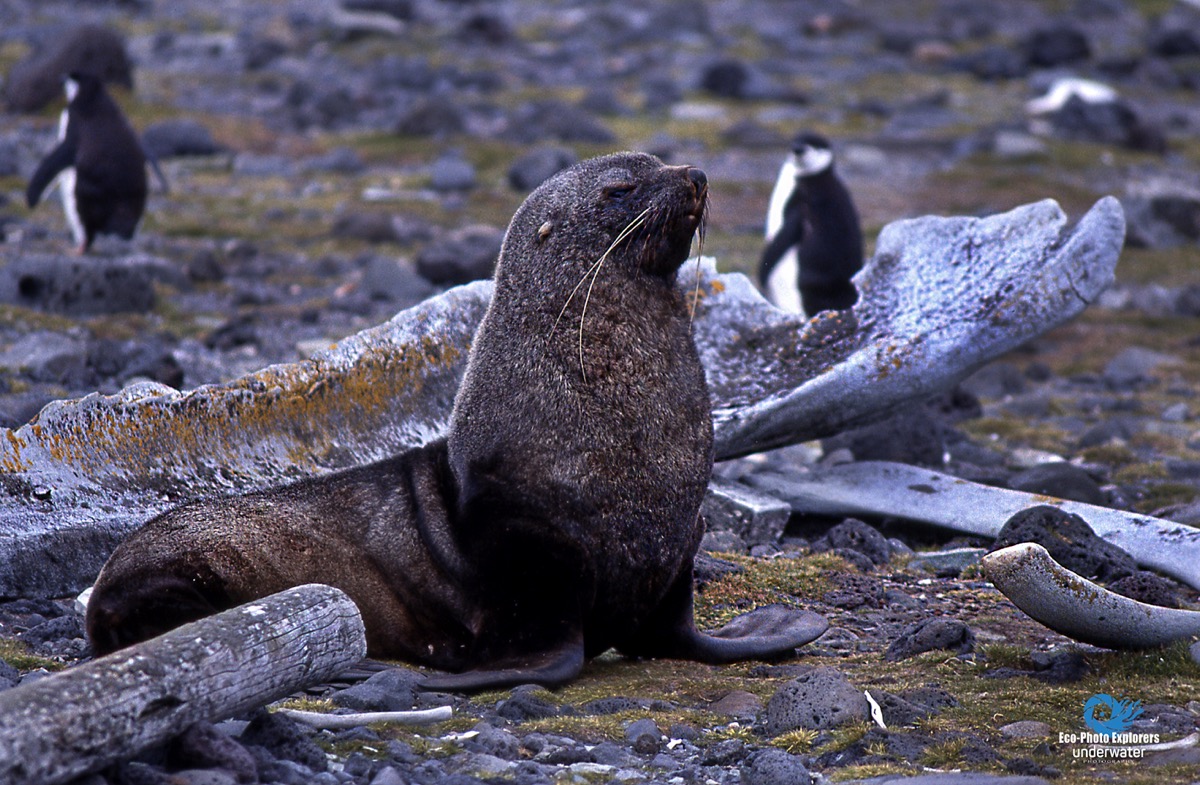
Antarctic Fur Seals are closely related to Sea Lions and Dogs
Less frequently seen underwater are the blubbery Weddell Seals, the Crabeater Seals and the Elephant Seal. Elephant Seals, in particular, are extremely large and should be avoided by divers as they can be very dangerous.
The apex predator of the Antarctic waters is the Leopard Seal. Second only to the Elephant Seal in size, the Leopard Seal can almost 12 feet (4 m) in length and weigh between 400 and 1300 lbs (200 to 600 kg). Their only predator is the Orca.
Leopard Seals are large predators presenting a potential risk to humans. Divers must be cautious around these animals. In 2003, biologist Kirsty Brown of the British Antarctic Survey was killed by a leopard seal while snorkeling in Antarctica. This was the first recorded human fatality caused by a leopard seal. But many divers and underwater photographers have safely and successfully interacted with these intimidating pinnipeds. For many, it is the ultimate challenge and the pinnacle of in water marine mammal encounters.
Diving with Seals and Sea Lions opens the diver to a realm of inter-species interaction that is far elevated from those of other creatures in the sea. With proper respect for the animal’s well-being, strict adherence to laws and regulations, and keen observations of how the animal is behaving in the moment, divers can safely enjoy these encounters in numerous locations around the world. Get out there and explore…the seals and sea lions are waiting!
Story and photos by Michael Salvarezza and Christopher P. Weaver
- A Galapagos Fur Seal warns not to approach too closely
- Say hello to a Grey Seal
- Grey Seals will often approach divers inquisitively
- Fisherman’s Memorial in Gloucester
- Divers prepare for a day of diving with seals off Gloucester, MA
- California Sea Lions surround divers in the Sea of Cortez
- A Grey Seal photographed in Gloucester
- The Savages, near Gloucester, makes for a great dive site
- Although the water is shallow at The Savages, divers check their gear before diving
- California Sea Lions cavorting in the diver’s bubbles
- A California Sea Lion investigates a dicer’s fins
- Snoozing Galapagos Fur Seals comprise the welcoming committee at the island’s port of entry
- Crabeater seals are often seen on ice flows in Antarctica
- Antarctic Fur Seals are closely related to Sea Lions and Dogs
- The Southern Elephant Seal is a formidable presence on the beach at Deception Island in Antarctica
- A Southern Elephant Seal rests ashore in Antarctica
- Despite the isolation, Antarctic Fur Seals will play with divers that they are meeting for the first time
- A Weddell Seal resting on a ice flow in Antarctica
- Leopard Seals are the apex predators in Antarctic waters
- A nursing juvenile Galapagos Fur Seal
- A sleeping Antarctic Fur Seal
- An endangered Hawaiian Monk Seal sleeps on the shores of Kauai
- The forbidden Hawaiian island of Niihau
- A Galapagos Fur Seal protecting its pup
- Underwater photograph of a Hawaiian Monk Seal
- Researchers carve numbers in the fur of Monk Seals for identification purposes
- A Hawaiian Monk Seal watches a diver from a safe distance
- A California Sea Lion makes a close approach in the Sea of Cortez
- A California Sea Lion poses for a portrait
- A group of California Sea Lions swirling in the waters of the Sea of Cortez
- What big eyes you have! A California Sea Lion from Mexico’s Sea of Cortez
- Male Sea Lions will challenge divers who get too close to the females
- California Sea Lions are master swimmers
- Author Christopher Weaver searches the kelp forests in California for Harbor Seals
- Sea Lions are playful, adept swimmers


